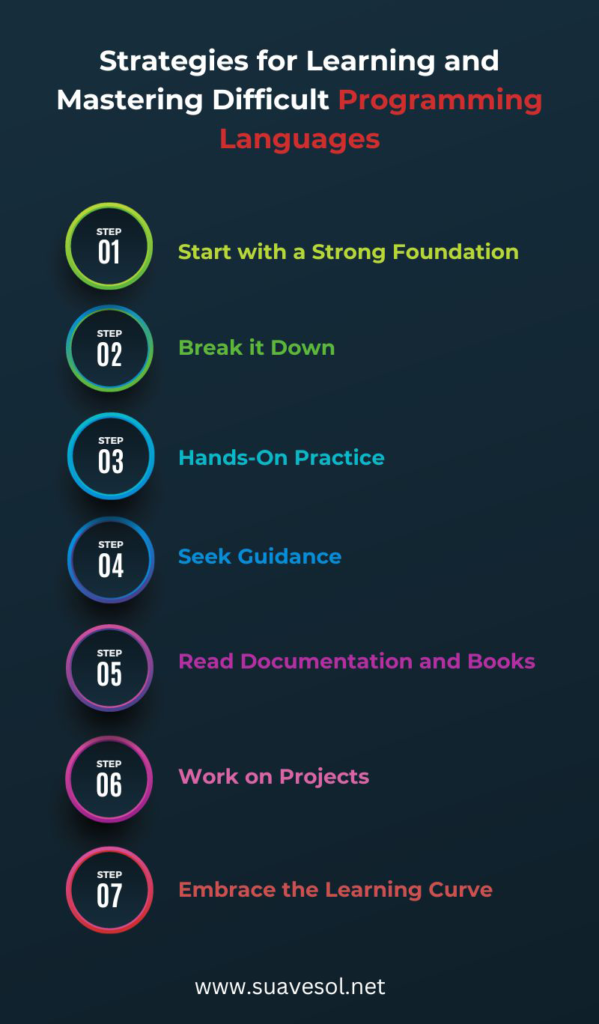Home » Blog » Web Development » 5 Most Hardest Programming Languages To Learn
5 Most Hardest Programming Languages To Learn

Programming languages serve as a unique communication tool that allows people to interact with computers and guide them through tasks. By embracing the challenge of learning complex programming languages, individuals gain the ability to tackle complex problems.
Mastering the hardest programming language to learn, enhances problem-solving skills, expands creativity, and equips individuals with the ability to tackle complex projects. It opens doors to greater opportunities and professional growth. In this blog, we’ll learn the significance of mastering challenging programming languages and the factors contributing to the complexity of these languages
Factors Contributing to the Complexity of Programming Languages
When it comes to programming languages, assessing their difficulty is a crucial endeavor. Several criteria shape this evaluation, including syntax complexity, learning curve, available documentation, and more. Let’s dive into the factors involved in the complexity of programming languages.
Syntax and Grammar
Languages with complex syntax and grammar rules can be challenging to understand and write code in, requiring meticulous attention to detail.
Learning Curve
Some languages have steep learning curves, demanding significant time and effort to grasp their concepts, features, and best practices.
Abstraction Levels
Languages that offer higher levels of abstraction may be more complex, as they provide greater flexibility and power but require a deeper understanding of underlying concepts.
Concurrency and Parallelism
Dealing with parallel execution in languages can be complex, as it involves managing synchronization, race conditions, and resource sharing.
Standard Libraries and APIs
Programming languages that have extensive libraries and APIs offer powerful functionality. However, they may require effort to learn their complex features and usage.
Documentation and Community Support
The complexity of documentation can make a language more challenging to learn. On the other hand, vibrant community support can ease the learning process.
Memory Management
Languages that require manual memory management, such as C or C++, introduce complexity due to the responsibility of allocating and freeing memory.
Tooling and Ecosystem
The availability and complexity of development tools, frameworks, and libraries associated with a language can impact the overall complexity and learning curve.
Note: By considering these factors, one can better understand and evaluate the complexity of programming languages. It helps programmers choose the right language for their projects and effectively navigate the challenges they present.
Top Most Challenging Programming Languages
Here are some of the most challenging and hardest coding languages:
Language 1: Python
Python is a versatile and widely adopted programming language that has gained immense popularity due to its simplicity and readability. While Python is generally considered beginner-friendly, certain aspects can pose challenges for learners. One such challenge lies in Python’s whitespace-sensitive syntax, which demands strict indentation rules, requiring attention to detail.
Additionally, Python’s Global Interpreter Lock (GIL) can limit its performance in multi-threaded applications. However, Python’s extensive standard library, rich ecosystem, and community support make it an attractive choice.
Language 2: Haskell
Haskell is a functional programming language renowned for its strong static typing and emphasis on mathematical principles. It stands out for its declarative and pure approach, where functions produce consistent results based solely on their inputs. Haskell’s difficulty lies in its paradigm shift from imperative languages, requiring learners to adapt to a different way of thinking.
Challenges may arise from concepts like lazy evaluation, higher-order functions, and advanced type system features. However, Haskell’s benefits are abundant, offering concise and elegant code, strong type safety, and support for concurrent programming.
Language 3: Malbolge
Malbolge is an esoteric programming language known for its extreme difficulty and intentionally confusing design. Created as a programming challenge, it was designed to be nearly impossible to write meaningful programs in. Malbolge’s complexity stems from its complicated instruction set and self-modifying code. Its purpose is to push the limits of programming comprehension and test the ingenuity of developers.
Learning Malbolge presents challenges in understanding its unconventional execution model and decoding its obfuscated syntax. With its deliberately torturous design, Malbolge serves as a curiosity rather than a practical programming language. Mastering Malbolge requires an exceptional level of perseverance, patience, and a willingness to dive deep into the world of programming.
Language 4: Whitespace
Whitespace is a unique and unconventional programming language that utilizes only whitespace characters (spaces, tabs, and line breaks) to write code. It disregards any non-whitespace characters, making it one of the most minimalistic programming languages. The difficulty in Whitespace lies in its lack of traditional syntax and reliance solely on invisible characters.
Understanding and interpreting code written in Whitespace can be a daunting task due to the absence of visual cues typically present in other languages. The challenges faced include identifying and distinguishing whitespace characters accurately. Whitespace’s characteristics include simplicity, elegance, and a focus on pure functionality. Its learning curve can be steep, requiring attention to formatting and a mindset that appreciates the minimalist nature of the language.
Language 5: Java
Java is a widely-used, high-level programming language known for its platform independence and validity. It follows an object-oriented programming (OOP) paradigm, emphasizing code reusability and modular design. While Java offers a beginner-friendly syntax and extensive documentation, it can be challenging due to its vast ecosystem and complex APIs.
Learning Java involves understanding concepts like classes, objects, inheritance, and exception handling. Challenges may arise in dealing with memory management, multithreading, and understanding advanced topics like generics and Java Virtual Machine (JVM) internals. Java’s characteristics include strong typing, automatic memory management through garbage collection, and its popularity for building enterprise-level applications.
Strategies for Learning and Mastering Difficult Programming Languages
Learning and mastering difficult programming languages can be a challenging but rewarding endeavor. Here are some practical tips and advice to help you on your journey.
Start with a Strong Foundation
Ensure you have a solid understanding of basic programming concepts before diving into a difficult language. Familiarize yourself with fundamental concepts like variables, loops, and conditional statements.
Break it Down
Break down complex concepts into smaller, manageable parts. Focus on understanding one concept at a time before moving on to the next. This incremental approach allows for better comprehension and retention.
Hands-On Practice
Engage in practical coding exercises and projects to apply what you learn. Building real-world applications helps solidify your understanding of the language and its features.
Seek Guidance
Join online communities, forums, or programming groups dedicated to the language you are learning. Interacting with experienced dedicated software developers can provide valuable insights, guidance, and support.
Read Documentation and Books
Utilize official documentation and recommended books for the language. These resources often provide in-depth explanations, tutorials, and examples to help you grasp complex concepts.
Work on Projects
Undertake challenging projects that align with your interests. Applying the language to solve real-world problems enhances your skills and deepens your understanding.
Embrace the Learning Curve
Understand that mastering a difficult programming language takes time and effort. Be patient, persistent, and don’t shy away from experimenting and making mistakes. Learning from failures is an essential part of the journey.
Summarizing!
Mastering most complex programming languages is, undoubtedly, a challenging task. You can tap into a vibrant programming community by embracing the learning curve. However, to state the facts, no one can master every programming language there is. To cater for the ever-evolving digital landscape, you can outsource your projects. Suave Solutions offer exceptional outsourcing solutions for every business domain. Hire software developers from Suave Solutions and leverage their expertise to stay ahead of the competition. You can also get team outsourcing for your web development projects. Get professional services and boost the potential of your business.
Frequently Asked Questions
Why is programming so hard?
The inherent complexities of syntax, concepts, and problem-solving make a programming language complex, challenging programmers to navigate its difficulties.
Is C++ the hardest programming language?
While C++ can be challenging due to its vast features and difficulties, the complexity of a programming language is subjective and depends on individual experiences and familiarity with different languages.
Is Python really that hard to learn?
Python is often considered beginner-friendly, but “hardness” is subjective. Python’s simplicity and extensive community support make it a popular choice for learners of all levels.
How to overcome the challenges of learning a complex programming language?
To overcome the challenges of learning a difficult programming language, embrace hands-on practice, seek guidance from communities, break down complex concepts, and stay persistent in your pursuit of understanding.
What is the hardest coding language to learn?
Determining the hardest programming language is subjective, as it depends on individual perspectives and familiarity. Each complex coding presents its own challenges and rewards, making it a matter of personal experience.
Recent Posts
- How To Hire Software Developers For Your Startup
- How UI/UX Design Can Make or Break Your Startup
- Best Places to Outsource Software Development Around the World
- Artificial Intelligence Outsourcing in 2025 – Best Practices, Cost, and Benefits
- Scrum Master vs Project Manager: Choosing the Right Leader for Your Project Success
Categories
- Business Solutions (8)
- Digital Marketing (2)
- E-Commerce (3)
- Mobile App (11)
- Software Developers (17)
- Software Teams (12)
- Team Outsourcing (12)
- Tech Trends (6)
- UI UX Design (4)
- Web Development (8)



